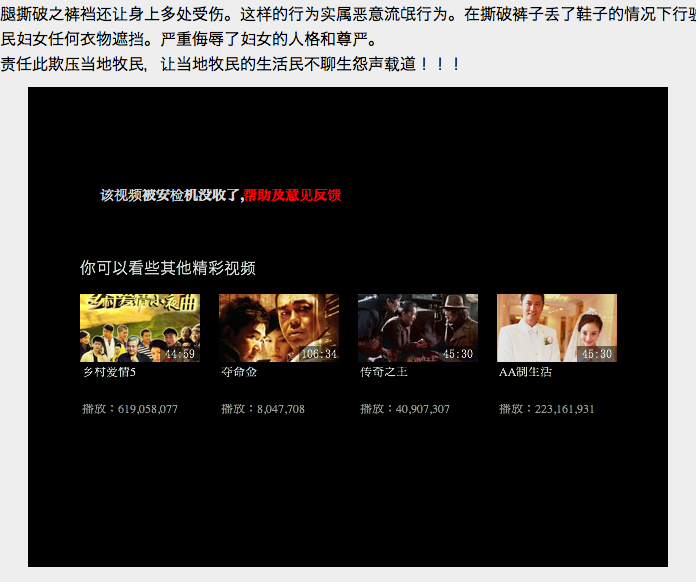| SMHRIC |
| July 8, 2012 |
| New York |
|
Conflict
between
the
herders
of
Eweenkh
Banner
and
local
police
|
|
|
Riot
police
seal
shut the
streets
of
Haliut
Town,
Urad
Middle
Banner (SMHRIC
photo)
|
|
As China declares the resettlement of the last remaining nomads over the next five years, tensions have risen in Southern (Inner) Mongolia between Mongolian herders and Chinese authorities over the illegal expropriation of herders’ grazing lands by government backed development projects. At least four separate protests by Mongolian herders have been reported in the last three weeks.
The most recent protest took place on July 2, 2012, in Imin Sum ("yi min su mu" in Chinese, "Sum" is equivalent to township), Eweenkh Banner ("e wen ke qi" in Chinese, "banner" is equivalent to county), Hailar Municipality ("hai la er shi" in Chinese) of eastern Southern Mongolia. According to an appeal letter to the Southern Mongolian Human Rights Information Center (SMHRIC) written by the herders of Imin Sum, local herders have lost large tracts of their grazing lands to government development projects. These projects concerning highway and rail track construction, mining and power plants were started in 1984 when a Chinese state-run company named Hua Neng Coal Electricity opened up a coal mine on their grazing lands.
"Today, the grazing lands have shrunk and the number of livestock reduced dramatically," the appeal states, "herders are burdened by heavy debts, with no medical care. Eighty percent of the males in the Sum are single due to their financial inability to have a wedding ceremony and raise a family." The appeal continues, "through means of deception and force, the Government is literally plundering our land," pointing out that a new government-backed project called "Hua Neng Wind Power Electricity" has already been launched in 2010 displacing 33 herders’ households from their grazing land without their consent. Several herders who attempted to block the construction from starting were beaten up and arrested by police favoring the interests of the land grabbers. Among the arrested was a Mongolian herdswoman who was publicly humiliated, sexually harassed and beaten up by police en route to the detention center.
Two weeks earlier, another round of conflict erupted between Mongolian herders in Imin Sum and Chinese land grabbers. Dozens of gang members hired by the local authorities attacked the Mongolian herders who were tending their livestock on the last piece of remaining grazing land. Many herders were beaten up and wounded. Among them were two herdswomen who were hospitalized. One of them is still unconscious.
On June 19, 2012, two other similar cases were reported in eastern Southern Mongolia, one in Ar Horchin Banner, the other in Urad Middle Banner.
An urgent appeal to SMHRIC from the herders of Balchiruud Sum of Ar Horchin Banner reported that Mongolian herders were protesting Chinese land grabbers who had illegally occupied their grazing lands and dug up their ancestral burial grounds with bulldozers. Herders were beaten up and arrested, and houses destroyed by police and land grabbers. Several herders were injured and hospitalized.
From June 19 to 20, hundreds of Mongolian herders took to the streets of Haliut Township ("hai liu tu zhen" in Chinese), Urad Middle Banner protesting the Chinese authorities’ "prohibition on livestock grazing". Protesters marched towards Haliut Township from all directions and gathered in front of the government building. Some marched toward the bus station of the township and blocked nearby traffic. Riot police were deployed immediately and streets and squares were sealed shut by the Chinese security forces. On the afternoon of June 20, some herders were arrested and taken away by police dispatches from their respective Sums.
Internet posts regarding these protests were immediately censored by Chinese internet police. Information on these conflicts posted on Chinese popular sites including Baidu Tieba, Renren, Xinlang and even personal blogs have quickly been removed. A notice reading "This post is under inspection" was posted by the Chinese Internet police after removing photos showing the Urad Middle Banner herders’ protest on a personal QQ Space. The video footage of the Imin Sum case was also immediately removed from TianYa Forum (www.tianya.cn). A message posted on the site states that "this video footage has been confiscated by Security Inspection Server".
Despite the rising tension between Chinese authorities and nomads all across China, the Chinese Central Government recently announced the solution to the nomad problem with the initiative to resettle the last remaining nomad populations totaling 246,000 households or 1.157 million herders, primarily Mongolians, Tibetans and Kazakhs over the next five years.








